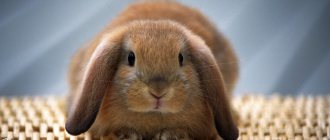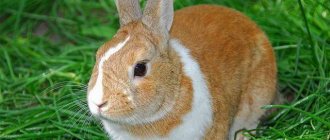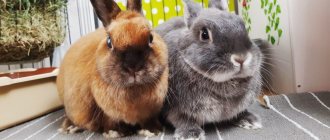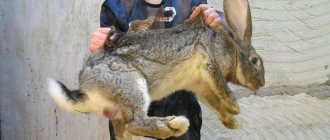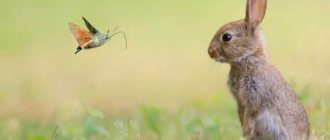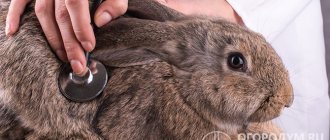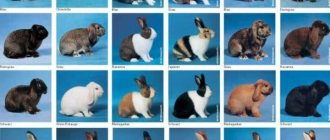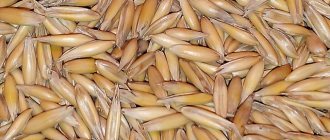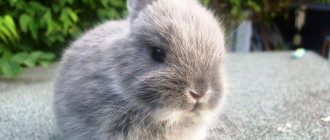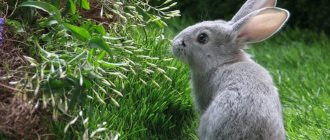Every breeder should know exactly how much a rabbit weighs and at what age it reaches its maximum weight. Knowledge of such nuances will allow you to judge the effectiveness of the chosen fattening method, as well as clearly determine the time of slaughter of the animal in order to obtain rabbit meat of the highest possible quality. But it is worth remembering that exact values are considered only in the context of a specific breed, each of which has its own characteristics and growth rates of living creatures.
domestic rabbit
Weight by breed
When choosing a breed, beginning rabbit breeders rely on maximum weight and conditions for weight gain. At the same time, they are studying the influence of various factors on the growth rate of rabbits.
| Breed | Weight, kg |
| Butterfly, Silver | 4-6 |
| Belgian Flanders | 6-12 |
| White giant | 6-8 |
| Blue Royal Giant, Californian, Soviet Chinchilla | 4-5 |
| German giant | 7-9 |
| New Zealand | 4,5-6 |
| Gray giant | 4-7 |
| Soviet Marder | 3-4,5 |
| French ram | 6-7, 5 |
| Black-brown | 5-7 |
A proper diet is the key to health!
I will repeat a common truth, which, however, most rabbit breeders lose sight of: rabbit food must be perfectly balanced. As experienced rabbit breeders say: If you feed only hay, the rabbit will only grow ears. Translating into a more scientific language, I will say that the speed of weight gain and the condition of the gastrointestinal tract of animals depend on the quality and calorie content of food.
Feeding only hay is an extremely low-calorie diet that will support life and healthy intestinal motility. To gain weight, animals need to be fed grain bait, whole grain or crushed grain. In addition, they are given mineral supplements and soft food. Instead of creating a menu manually, it is easier to purchase ready-made feed - a balanced mixture of grains, bone meal and minerals.
A varied diet is the key to the health and rapid growth of a rabbit.
Minerals are especially needed by breeding animals and those breeds that are raised for fur. Grain mixtures containing legumes, corn, sunflower or rapeseed are available for sale. These supplements are high in calories and promote weight gain.
There are foods that are contraindicated for animals:
- fresh grass on which pathogenic bacteria are present, because in 95% of cases, epidemics that can destroy livestock in the territory of an entire village are transmitted precisely through fresh leaves;
- some types of plants containing toxins: foxglove, lily of the valley, henbane, colchicum, lumbago, buttercup and others;
- branches of stone fruit trees and the essential oils they contain are toxic to animals;
- bread crumbs can clog the intestines, which leads to the painful death of animals within 24 hours.
Weight by month
Each animal has its own characteristics and develops individually. By monitoring the growth of rabbits of different breeds, scientists derived average growth rates by month. Animals usually gain maximum weight for slaughter by the 8th month of life, sometimes by a year.
| Breed | Weight, g | |||||||||
| Age, months | 0 | 1 | 2 | 3 | 4 | 5 | 6 | 7 | 8 | |
| Butterfly | 50 | 600 | 1600 | 2400 | 3200 | 3600 | 3900 | 4100 | 4300 | |
| Belgian Flanders | 100 | 800 | 2600 | 3600 | 4700 | 5500 | 6300 | 7000 | ||
| White giant | 70 | 700 | 2300 | 3400 | 3800 | 4200 | 4600 | 5000 | ||
| Blue Royal Giant | 600 | 2100 | 2900 | 3200 | 3600 | 4000 | 4200 | |||
| Californian | 50 | 500 | 1500 | 2700 | 3100 | 3500 | 3800 | 4100 | 4300 | |
| German giant | 900 | 1200 | 3200 | 4800 | 6400 | 7100 | 7800 | 8500 | 9000 | |
| New Zealand | 60 | 600 | 1600 | 2500 | 3200 | 3500 | 3800 | 4100 | 4300 | |
| Silver | 500 | 1500 | 2200 | 3100 | 3700 | 4200 | 4700 | 5000 | ||
| Gray giant | 600 | 3000 | 3600 | 4100 | 4600 | 4800 | ||||
| Soviet Marder | 500 | 1400 | 2100 | 2900 | 3200 | 3600 | 4000 | 4200 | ||
| Soviet chinchilla | 600 | 1500 | 2800 | 3100 | 3500 | 4000 | 4300 | 4800 | ||
| French ram | 80 | 1000 | 2400 | 2600 | 3800 | 4300 | 4400 | 5300 | 5500 | |
| Black-brown | 700 | 1600 | 2500 | 3200 | 3600 | 4000 | 4500 | 4800 | ||
How to choose?
Before you decide on a particular breed of giant rabbits, you need to know for what purposes you plan to buy them. In Russia, farmers prefer to grow both meat, fur, and ornamental breeds.
Since the market is represented by a chic selection of pets, during the purchase you need to be extremely careful, since you can buy a far from purebred species by trusting the simple words of sellers. For example, many ordinary spotted rabbits are passed off as the butterfly breed, but their weight does not correspond to the characteristics of giant rabbits.
Experts advise purchasing animals from special nurseries or farms that have good reviews.
Growth characteristics of rabbits
Rabbits are born blind, with 16 baby teeth. After a week, their body is covered with the first fluff; over the course of a month it increases and by the 25th day it becomes full-fledged fur.
On the tenth day of life, they open their eyes, and on the 20th they are able to leave the home and eat food. Milk teeth fall out on the 18th day of life, after 10 days permanent teeth appear.
The period of birth influences the development of newborns. Those born in winter or early spring grow faster, unlike rabbits born in summer or autumn. Babies are born very tiny, weighing 40-100 grams. After a week, their weight doubles, and within a month - 10 times.
This is facilitated by the composition of mother's milk, enriched with nutrients: fats 10-20%, proteins 13-15%, calcium 0.60-0.70%, phosphorus 0.40-0.50%, milk sugar 2%.
Lactating females produce milk abundantly in the summer. The highest rates are for Californian and Soviet chinchillas, the lowest for New Zealand ones.
Until 3-4 months, the growth rate of rabbits is high, then gradually decreases. At this age they become sexually active. They have a very weak spine and limbs that they can easily break. The skeleton is fully formed by the first year of life.
Record holders among long-eared animals
Ralph Rabbit's story is like a roller coaster. Paulina Grand's ward is considered the largest. But doctors are seriously concerned about the pet’s well-being. Today, the weight of the big-eared celebrity is 22 kg, although the owner assures that she provides the rabbit with physical exercise. However, the giant is outwardly active and does not show any dissatisfaction with its maintenance or care. The body length of the playful domestic hare is 130 cm.
Darius is another former Belgian breed record holder. In 2010, he even managed to dislodge Ralph, however, after that he lost ground with a weight of 19 kg. His owner, Annette Edwards, had previously registered large rabbits in the Book of Records; they were the parents of Darius. Apparently, the hereditary factor played a huge role in this particular case. The length of the body in 2010 was inferior to the current leader. True, according to some reports, the pet will soon snatch the palm from Ralph again. The owner claims that the rabbit gained weight 22.2 kg and grew to 130 cm.
Jeff is the son of Darius, so it is not surprising that the whole world expects big victories from him. Annette, as a specialist in breeding ornamental breeds, is confident that Jeff will become a record holder. Now the rabbit is 3 years old, but its body length is already 95 cm. Miss Edwards is happy to tell the secret of such success in an interview. First of all, this is a balanced diet, as well as physical exercise. For example, Darius’s weight, as Annette admits, is largely determined by muscles. He is very active, runs constantly, and his caring owner spends the lion's share of her financial resources on quality maintenance. The price of good food for large breeds is high, which forces the farmer to turn to relatives for help.
What affects weight gain
In addition to genetic data, a properly formed diet is important. It includes different types of feed, vitamins and minerals. Rabbits have a very unique digestive system (food should always be in the gastrointestinal tract), so they are fed in small portions several times a day: 4 times for a nursing rabbit and newborns, for other animals 2-3 times are enough. But there should be hay in the cage all the time. Access to clean drinking water is provided freely.
For the normal functioning of the gastrointestinal tract, it is necessary to adhere to the chosen diet and avoid sudden changes in food. Of the vitamins, special attention should be paid to A, D, C, E, B.
There are special additives - growth stimulants. They not only accelerate weight gain, but also strengthen the immune system and build resistance to diseases. The dose of such a drug is calculated based on the nutritional characteristics and age of the animal.
The growth of rabbits depends on their physical condition. To maintain the health of individuals, they organize comfortable living conditions, adequate care, and maintain high-quality nutrition.
Nutritional supplements for artificial weight gain
To improve appetite, breeders add vitamins to pet food. Beneficial substances of groups A and E are used together with fats, vitamin D is added to thick and porridge-like food. The drink is diluted with vitamin C.
After consultation with a veterinarian, animals are prescribed vitamin-mineral, as well as protein-vitamin-mineral supplements (PVMD).
They strengthen the animals’ bodies with useful microelements: manganese, calcium, phosphorus. Protein-containing options provide protein to the animal's muscles.
Vitamin and protein supplements have no contraindications. The correct dosage is calculated taking into account the body weight and age of the pet. The use of additives above the norm worsens the taste characteristics of rabbit meat.
Gray giant
Brought out in the mid-19th century by the research center at the Poltava State Animal Farm named after. Petrovsky. Crossing was carried out between large Flanders and local forms. From Flanders, the new species inherited a developed skeleton, height and large mass, from ordinary rabbits - high viability at low temperatures, resistance to disease, unpretentiousness in care and feeding.
Although Gray Giants are inferior in meat yield and speed of maturation to other giant breeds, their adaptability to climate conditions has made the breed popular in Ukraine, Russia, and the Baltic states. They are bred well in Siberian rabbit farms, where conditions are not as mild as. They take root well at home, becoming beloved pets.
Standard indicators
If we talk about average indicators, then the weight of a rabbit should be from 4 to 5 kg, however, in practice, there are cases when record holders with a weight of 8 kg grew up on farms in those breeds that are not characterized by such an indicator. The weight of a two-week-old regular rabbit is no more than 45 grams, but it may be less, depending on the breed.
Table of weight in grams by month.
You need to understand that live weight and slaughter weight are not the same thing and the difference between them is 30%, which includes the skin and internal organs. With a live weight of a rabbit of 5 kilograms, the slaughter yield is only 1.5 kg. If a live rabbit weighs 10 kg, then the carcass is only 7 kg.
Newborn rabbits weigh very little, they are hairless and blind. Month-old offspring feed exclusively on mother's milk; as a result of such a balanced menu, their weight increases 10 times. Despite the fact that the weight no longer increases at this rate, it still continues to grow, and by 5 months the rabbit has gained 70% of its maximum weight. On average, a healthy animal should weigh 3.5 kg by the specified date.
It is worth saying that only large breeds, which are distinguished by record performance, are grown for commercial purposes. They differ from other breeds in that they grow quickly and after only 9 months they are ready for slaughter. An adult rabbit reaches its maximum weight at 10 months.
A newborn rabbit weighs only 62 grams; by 1 month it increases to 800 grams. At 3 months his weight is 2700 g, at 4 months - 3.6 kg and by 6 months - 5.5 kg. The weight gain is 50-60 grams per day.
Video
More detailed information about breeding giant rabbits can be obtained from the video:
The following video will help you properly organize your rabbits’ diet during the cold season:
About the author:
Found a mistake? Select the text with the mouse and click:
Ctrl+Enter
Do you know that:
Compost is rotted organic remains of various origins. How to do it? They put everything in a heap, hole or large box: kitchen scraps, tops of garden crops, weeds cut before flowering, thin twigs. All this is layered with phosphate rock, sometimes straw, earth or peat. (Some summer residents add special composting accelerators.) Cover with film. During the process of overheating, the pile is periodically turned or pierced to bring in fresh air. Typically, compost “ripens” for 2 years, but with modern additives it can be ready in one summer season.
Farm
Video example
Let us immediately note that the accelerated rabbit is not some special breed, but just the result of growing technology. So, let's look at a small example for organizing a rabbit breeding farm.
First, a video about industrial rabbit breeding:
Production plan
Mikhailov’s methodology proposes the creation of mini-farms, the so-called “MIAKRO mini-farms”. It is installed on an area of approximately 1.4 square meters. m and about 13 rabbits are placed there, although this number, if desired, can be increased up to 30 animals.
Each year you will need 500 kg of feed per farm, as well as 250 kg of hay. One accelerator consumes up to 7 kg of hay and up to 14 kg of feed. If the capital turnover rate is 100 days, you can count on one rabbit weighing 4-6 kg and weighing one decade.
There can be different types of mini-farms, including two-tier ones, and you will have to determine their number yourself - it all depends on the capabilities of your site. If you have, for example, 16 pieces, then they will occupy an area of only one hundred square meters, produce a dozen rabbits a week and require weekly maintenance.
The remaining technical characteristics are as follows - 30-40 minutes of care if there are feeders with hay, an automatic drinker and a feeder with a gravity mechanism. If it gets cold outside and the temperature drops to +10 °C, then the energy consumption for heating will be 30 watts.
The main farm is located in St. Petersburg, where you can also order a training program, literature on the principles of raising giant rabbits and technical drawings of mini-farms. Help can also be provided at other farms - “Caligula” in Novosibirsk, UNPK “BelAKRO” in Belgorod.
Of course, good prospects for small business can open up when, in addition to the farm, you can create a processing workshop, sew outerwear from rabbit fur, and also produce your own vermicompost.
Farm totals
If we talk about benefits, then the final figures for the above example of a small farm will look something like this:
- production of a mini-farm – 5-20 thousand rubles;
- output of finished products – starting from 100 kg of rabbit meat, 55-60 skins;
- payback of the project – 6-8 months;
- with a farm of 300 mini-farms (minimum recommended effective size), expenses will be at the level of 350 thousand rubles. per year, and income is about 1.5 million rubles.
The price of a kilogram of a rabbit carcass is approximately 300-350 rubles. As a business, this activity is quite profitable.
